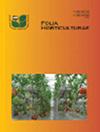Inhibitory action of ginkgolic acid against pathogenic fungi and characterisation of its inhibitory activities on Nigrospora oryzae
IF 2.2
4区 农林科学
Q2 HORTICULTURE
引用次数: 1
Abstract
ABSTRACT Ginkgolic acid is a natural plant antifungal substance with important biological activities, present in the testa of Ginkgo biloba. This research aims to analyse the antifungal action of ginkgolic acid against pathogenic fungi. Ginkgolic acid was analyzed by HPLC and FTIR, and the in vitro inhibitory activities of ginkgolic acid against pathogenic fungi has been investigated. Results showed that ginkgolic acid was a small hydrophobic molecule composed of five ginkgolic acids and their derivatives, with the alkyl and phenolic hydroxyl groups being located on the skeleton of the aromatic ring. Among Nigrospora oryzae (N. oryzae), Alternaria alternata (A. alternata) and Penicillium expansum (P. expansum), ginkgolic acid showed the strongest inhibition against N. oryzae, and the inhibition rate of ginkgolic acid at 5 mg · mL-1 reached 65.82%. Ginkgolic acid lysed the cell membrane of N. oryzae, causing the leaking of the mycelial protein and enhancement of the permeability of the cell membrane, which caused the electrical conductivity of the liquid medium to increase. In addition, it also decreased the activities of superoxide dismutase and catalase in the mycelium of N. oryzae, thereby weakening the cell’s protective function by damaging the integrity of the biomembrane. Furthermore, ginkgolic acid can effectively protect the leaves of Epipremnum aureum from infection by N. oryzae. It was concluded that ginkgolic acid effectively inhibited the activity of N. oryzae.银杏酸对病原真菌的抑制作用及其对米黑曲霉抑制活性的表征
银杏酸是一种具有重要生物活性的天然植物抗真菌物质,存在于银杏种皮中。本研究旨在分析银杏酸对病原真菌的抗真菌作用。采用高效液相色谱法和红外光谱法对银杏酸进行了分析,并考察了银杏酸对病原真菌的体外抑制活性。结果表明,银杏酸是由5种银杏酸及其衍生物组成的疏水性小分子,烷基和酚羟基位于芳环骨架上。在米曲霉(N.oryzae)、Alternaria alternata(A.alternata)和扩展青霉(P.expansum)中,银杏酸对米曲霉的抑制作用最强,银杏酸在5mg·mL-1时的抑制率达到65.82%,导致菌丝蛋白的泄漏和细胞膜渗透性的增强,从而导致液体培养基的电导率增加。此外,它还降低了米曲霉菌丝体中超氧化物歧化酶和过氧化氢酶的活性,从而通过破坏生物膜的完整性来削弱细胞的保护功能。此外,银杏酸还可以有效地保护金合欢的叶片免受稻瘟病的感染。结果表明,银杏酸能有效地抑制稻瘟病菌的活性。
本文章由计算机程序翻译,如有差异,请以英文原文为准。
求助全文
约1分钟内获得全文
求助全文
来源期刊

Folia Horticulturae
Agricultural and Biological Sciences-Horticulture
CiteScore
3.40
自引率
0.00%
发文量
13
审稿时长
16 weeks
期刊介绍:
Folia Horticulturae is an international, scientific journal published in English. It covers a broad research spectrum of aspects related to horticultural science that are of interest to a wide scientific community and have an impact on progress in both basic and applied research carried out with the use of horticultural crops and their products. The journal’s aim is to disseminate recent findings and serve as a forum for presenting views as well as for discussing important problems and prospects of modern horticulture, particularly in relation to sustainable production of high yield and quality of horticultural products, including their impact on human health.
 求助内容:
求助内容: 应助结果提醒方式:
应助结果提醒方式:


